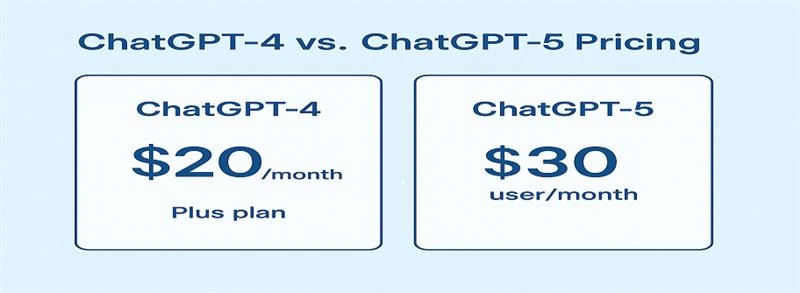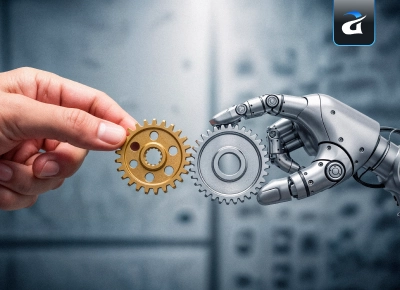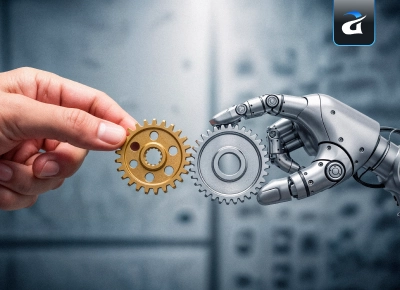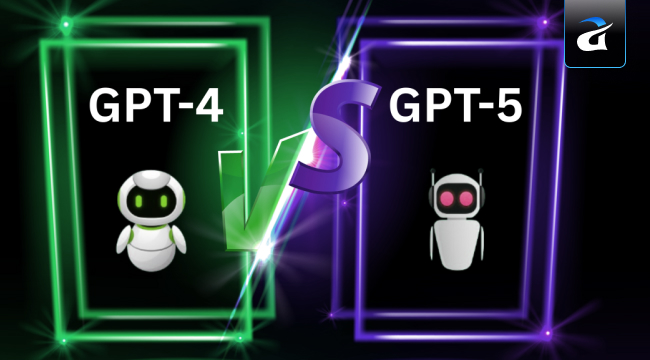Now, here’s where things really get interesting—ChatGPT-5, launched on August 7, 2025, is a multimodal large language model.

You'll be as flabbergasted as I was when I first found out that ChatGPT-5, like AI agents, is an absolute stunner: It can think, reason and understand more deeply than we assumed it would do as a mere AI machine, proving itself to be the right definition of a futuristic technology and a total jack of all trades. Let’s fully discover ChatGPT-5 comparison to ChatGPT-4.
ChatGPT-5 Features & Capabilities vs. ChatGPT-4
| Feature | ChatGPT-4 | ChatGPT-5 |
| Memory / Context Window | Can handle around 32,000 words at once. | It can take on about 256,000 words. |
| Multimodal Input (text, image, audio, video) | Supports text and images; limited or separate modules for audio/vision | Unified multimodal: is able to handle images, sound, video, and code in one chat. |
| Adaptive Reasoning (“thinking mode”) | Not typically; one mode per prompt. | Automatically switches between quick replies and deeper thinking depending upon the difficulty of the question. |
| Personalization / Personality | Some via system prompts, but static. | Includes ready-made personalities (like “Listener” or “Robot”) and lets you adjust how it talks. |
| Tool / Plugin / Agent Integration | Plugins, tool use available (e.g. web browsing, function calling). | Built-in connectors in it (Gmail, Calendar, SharePoint etc.). |
| Error Detection & Self-Awareness | Can refuse but still hallucinations can appear. | Better built-in verification, and more honesty. |
Speed: ChatGPT-5 vs ChatGPT-4
The speed of an AI isn’t confined to merely "quickness"—it’s also about how many requests it can handle at the same time. Therefore, we call these two things latency (response time) and throughput.GPT-4: It was already a big step up from earlier models—it did give us good replies in the blink of an eye and was able to manage even complex conversations without lag. Still, it sometimes slowed down when dealing with long or detailed prompts.
GPT-5: It takes this a step further. It’s designed to adjust its speed automatically depending on what you ask. For simple questions, it replies you immediately! For harder or multi-step problems, it switches into a “thinking mode,” where it takes slightly longer but gives deeper, more accurate answers.
Early benchmarks, especially in coding and logic-based tests, show that GPT-5 not only solves problems faster than GPT-4 but also uses fewer resources to do so. It’s more stable under heavy use and offers a smoother experience overall—think of it like GPT-4 on turbo mode: same intelligence, but quicker on its feet and more energy-efficient
Energy taken by GPT
Despite the never-ending benefits of generative AI here arrives the catch—more power requires more energy. According to studies, a normal GPT-5 response takes 40 watt-hours (Wh) of energy—that’s about eight times more than GPT-4. You must be wondering, why? It’s because GPT-5 does more thinking behind the scenes. It processes quite deeply, handles multimodal inputs, and also switches between modes, so naturally, this all takes more energy.Experts say this makes GPT-5 faster and smarter, but not without cost, because too much energy use can’t be good for the environment.
Chatgpt-5 Accuracy, Hallucinations & Reliability vs. ChatGPT-4
If I'm being honest, none of us would be paying any mind to these ChatGPTs if all they did was dump us with some false information that we have zero eagerness in learning. So, this makes it crystal clear that accuracy is quite, in fact, utterly important to us users, don’t you agree?Here’s how GPT-5 performs compared to GPT-4:
Benchmark Scores:- On the MMLU benchmark, GPT-5 has scored 91.4%.
- GPT-4.1 scores 90.2%, showing GPT-5’s slight but meaningful edge.
Fewer Hallucinations:
- GPT-5’s hallucination rate is 1.4%, while ChatGPT-4’s hallucination rate is 1.8%.
Lower Error Rates:
- GPT-5’s error rate is 45% lower than GPT-4o’s.
- In advanced reasoning mode, the difference jumps up to 80% fewer errors.
Coding Benchmark:
On SWE-Bench (a coding accuracy test), GPT-5 achieves around 74.9% accuracy, showing solid improvement in technical reasoning.
Hallucination and Overconfidence
Even with better accuracy, GPT-5 isn’t perfect — it still makes mistakes sometimes:
Factual Error Rate:
- GPT-5’s hallucination rate is about 1.4%, down from GPT-4’s 1.8%.
It can still sound sure about wrong answers, especially with rare or complex topics.
Use Cases of ChatGPT-5 vs ChatGPT-4
Let’s compare how GPT-4 and GPT-5 behave in real life tasks as one of the greatest AI tools.Writing, Content & Summaries:
- GPT-5 handles very long documents better (due to big context window).
- It adapts tone more flexibly.
- It is less likely to drift off topic or repeat itself in long conversations.
- Best for Human and AI collaboration.
Coding & Debugging
- GPT-5 tends to give cleaner, more correct code, detect bugs, and reason across modules.
- It can more confidently explain code and suggest improvements.
Visual & Multimodal Tasks
- GPT-5 can take in diagrams, screenshots, along with text, plus due to its voice vision technology it can also understand audio and video which helps in many real-world tasks (e.g. “Here is a wiring diagram — what’s wrong?”).
- GPT-4 supports images plus text, but not full audio/video in the same channel.
Workflows & Integration
- GPT-5’s connectors (e.g. to calendars, email, enterprise systems) let it act as part of your workflow.
- GPT-4 can use plugins or external tools, but integration is less tight or native.
Trade-offs, Limitations & User Experience
It’s not all gains—there are trade-offs and caveats to consider.- Cost & infrastructure: Running GPT-5 is more expensive in computation, energy, and hardware.
- Latency for complex tasks: Deep reasoning mode may introduce pauses.
- Overfitting or overconfidence: In rare domains, GPT-5 might amplify errors if data is scarce.
- Hallucinations remain: It is better, not perfect.
- Transparency & interpretability: You won’t always know why it gave an answer.
- Access & availability: Some features might only be in pro/paid tiers initially.
ChatGPT Pricing and ChatGPT sign up guide

From OpenAI’s official ChatGPT pricing page:
- Free tier: $0/month (limited access).
- Plus tier: $20/month (you will get faster responses, more right answers, and access to better models).
- Pro tier: $200/month (your will get extended usage limits, early access to features, etc.).
- Business / Enterprise: $25/user/month (when billed annually) for Business.
Because GPT-5 is now integrated into ChatGPT, the “ChatGPT Plus / Pro / Business” plans all give you access to GPT-5 capabilities (and earlier models) depending on your tier.
API / developer pricing
If you refer to using GPT-4 or GPT-5 via OpenAI’s API, the pricing is token-based:
For GPT-5 (flagship model):
- Input tokens: $1.25 per million
- Output tokens: $10 per million
For GPT-4 / GPT-4.1 / earlier versions, the pricing is different (e.g. older models had ~$2 input / $8 output per million tokens).
New Features in GPT-5 vs GPT-4
Here is a list of features that are new or significantly improved in GPT-5 (or not present in GPT-4):- Thinking mode / adaptive reasoning: GPT-5 dynamically shifts between faster “light” reasoning and deeper “thinking” when complexity requires.
- Much larger context / memory window: GPT-5 can handle far more tokens in one session (e.g. very long documents or conversations) than GPT-4.
- Better multimodal integration: GPT-5 unifies text, image, audio, video, and code in a more seamless way than GPT-4.
- Reduced hallucination / error rate: Through improved verification, internal checks, and better training, GPT-5 lowers false or fabricated outputs.
- Stronger performance in domain: GPT-5 sets new state-of-the-art scores in coding, math, health, multimodal understanding.
- Tool / agent integration enhancements: GPT-5 more tightly integrates with external tools, agents, and internal modules. (While GPT-4 had plugin systems, GPT-5 offers deeper native support.)
- Variants for cost control (Mini, Nano, etc.): GPT-5 comes in lighter versions (Mini, Nano) for lower cost use cases.
- More efficient pricing / token cost structure: GPT-5’s pricing is (in many respects) more favorable or competitive compared to previous “o” and “4” models.
Who Should Choose GPT-4 vs GPT-5
When you should choose GPT-5- If you deal with many difficult tasks, that need deep thinking (like research, technical work), then ChatGPT 5 is best for you.
- To get the right answers, with little to no mistakes.
- Handling very large files or long projects (like big documents, multi-step coding, or combining images with text) that might be too much for GPT-4.
- Cases where even a small mistake can be costly, so a stronger and more reliable AI is needed instead of something that’s just “okay”.
- If your tasks are simple—like short questions, small summaries, casual conversations, or content where perfect accuracy isn’t very important.
- If cost, speed, and saving resources matter more to you than having the most advanced AI.
- If you want faster replies instead of deep, detailed reasoning.
- If your current system already works well with GPT-4 and you don’t want to make big changes.
Comparative Summary Table
| Category | ChatGPT-4 | ChatGPT-5 |
| Context Window / Memory | 32,000 words (approx.) | 256,000 words (approx.) |
| Multimodal Support | Text + Images (limited audio/vision via separate tools) | Fully unified multimodal: text, image, audio, video, and code in one chat |
| Reasoning Ability | Standard reasoning | Adaptive “thinking mode” — switches between fast or deep reasoning |
| Personalization | Limited system-prompt based. | Custom personalities + adjustable conversation style. |
| Tool / Workflow Integration | Plugins and tool access | Built-in connectors (Gmail, Calendar, SharePoint, etc.) |
| Hallucination Rate | Higher error and hallucination frequency | fewer hallucinations |
| Coding & Technical Performance | Strong | Stronger with higher accuracy |
| Speed & Latency | Fast, but slows with long prompts | Faster, smarter speed adaptation + higher stability |
| Energy Usage | Lower energy consumption | Takes more energy due to heavier reasoning and multimodal processing |
| Use Case Strength | Best for casual use, basic tasks, short content | Best for research, large projects, and complex technical work |
| Limitations | Smaller memory, some hallucination, weaker multimodal | Higher cost, more energy usage, occasional overconfidence |
Gemini vs ChatGPT
Since we’re already at the topic, let’s also highlight the most asked question from a myriad of individuals: Gemini or chatgpt? Which is better?Gemini (by Google)
- Built for deep multimodal tasks (images, video, audio, text together)
- Strong for fact-based queries due to Google Search integration
- Excels in reasoning for math, coding, and structured problems
- Sometimes gives shorter, less creative responses compared to ChatGPT
ChatGPT (by OpenAI)
- Best for writing, creativity, storytelling, and conversation flow
- More natural, human-like responses in chat
- Strong code generation and debugging with detailed explanations
- Better third-party integrations through the ChatGPT ecosystem
- Excels in complex, long-form reasoning and memory
- Gemini= great for facts, Google tools, and multimodal tasks
- ChatGPT= great for creative tasks, conversations, and coding quality
Claude AI vs ChatGPT
Another great competition to ChatGPT is Claude AI:Claude AI
- Excellent for long documents (very large context window)
- Strong in creative writing, tone control, and summaries
- Designed with high safety and ethics in responses
- Helpful for writers, analysts, and professionals who need structured output
- Sometimes features aren't as rich as ChatGPT in tools and integrations
ChatGPT
- Best for tasks which need creativity, and problem-solving
- Very great for coding, research, brainstorming, and detailed explanations
- Offers more integrations (voice, vision, plugins, apps, etc.)
- Feels more natural and human-like in chat
- Great all-rounder for students, developers, and creators
- Claude AI = Ideal for long text, summaries, and professional writing
- ChatGPT = Ideal for deep reasoning, coding, creativity, and versatile tasks
Conclusion
Well, ChatGPT-4 and ChatGPT-5 may be distinct from one another, they still remain two sides of the same coin. While you can attain good responses and solve your problem via ChatGPT-4, ChatGPT-5 is more reliable in terms of giving better, in-depth and correct answers to you! That's the main difference these two have. However, Chatgpt-4 is cheaper in terms of cost while chatGPT-5 is slightly expensive. Try to choose the option considering your need and budget.If you have any queries in mind, feel free to reach out!
Frequently Asked Questions
What is ChatGPT 4?
Good question! Well, ChatGPT-4 is actually an AI driven chatbot by OpenAI. In very easy words, we can say that it’s like any normal chatbox—except that instead of humans you are having a full conversation with a machine robot. ChatGPT-4 is the upgraded version of ChatGPT-3, it analyzes your problems and queries, and gives you a solid solution. The most phenomenal part of it is that it creates content for you, as well as it looks at images, and helps with many different tasks.
What is the difference between ChatGPT 4 and ChatGPT 5?
The main difference between ChatGPT-4 and ChatGPT-5 is that ChatGPT-5 is more fast, accurate and can understand your problems better. Plus, it is also good at providing you with answers which require in-depth research, as well as it can understand audio, video and images.
What is the best way to use ChatGPT?
If you want to fully advantage from ChatGPT, then you explain to it your goal very clearly, mention context and the tone or format you want. This way, you can get a very good response from ChatGPT. For example, asking “Write a friendly 150-word blog introduction about AI for beginners” gives direction and leads to a better result than a general request.
What does ChatGPT 5 do better?
ChatGPT-5 gives more accurate replies, works faster, understands longer content, and handles complex tasks with better reasoning. It also offers smoother conversations and improved support for voice and images compared to earlier versions.
Is upgraded ChatGPT faster?
Yes, the newer version is faster. It can handle complex requests more quickly while giving accurate responses and keeping the conversation smooth, which makes the overall experience better.
What to expect from ChatGPT 5?
With ChatGPT-5, users can expect clearer reasoning, more natural conversations, better multimodal features, and stronger support for longer tasks. It is designed to feel more like talking to a real expert, with higher accuracy, more creativity, and improved productivity.



